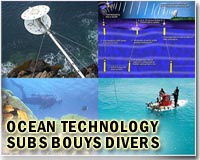| . |  |
. |
Canberra, Australia (SPX) Apr 22, 2010 An A$11 million collaboration aimed at helping Australia translate science into practical applications for adapting to climate change, population growth and other coastal pressures will be launched in Perth. Led by Curtin University of Technology, the CSIRO Flagship Coastal Collaboration Cluster will tackle the challenge of how to present and communicate scientific results in ways that are both understandable and useful to people who make complex decisions about the future of our coasts. The partners will use techniques such as Google Earth and custom-built animations to visualise research data and phenomena like sea-level rise. CSIRO Wealth from Oceans Flagship Director, Dr Tom Hatton, says Australia's coasts are facing mounting pressures from urban and industrial development, population growth, recreation and tourism, and climate change. "Science is often expected to provide key information to help with decisions about coastal management, but the expectations people have of science are often very different from what it can actually deliver," Dr Hatton says. "We feel that the solution is neither to 'dumb down' the science, nor expect non-scientists to master complex and diverse scientific fields. "What we are looking for is a way to make great coastal science accessible to the people who need to understand it. This will require creativity and innovation." Researchers involved in the Cluster will meet this challenge by collaborating with a wide range of people who make decisions about the future of our coast, including; scientists, local, state and federal governments, non-government organisations, indigenous leaders and the community. They will also investigate what scientific knowledge would be most helpful to these groups and develop and test new methods to both retain scientific accuracy and help groups to use the science in the decisions they make. Curtin Deputy Vice-Chancellor (International) and Cluster Leader, Professor David Wood, says the Cluster will simplify the knowledge needed to make decisions about Australia's coasts. "Making decisions about the future of our coasts is often complicated and involves a wide range of views about problems and solutions. "Finding practical ways to translate the science and bring all these views together will enable coastal policy-makers and planners to access and use the best scientific, lay, indigenous and managerial knowledge available in their daily work," Professor Wood says. The research will extend across vulnerable coastal regions from Mandurah in Western Australia to the Derwent-Huon region in Tasmania through to south-east Queensland. The three-year project is a collaboration between the Curtin University of Technology, the University of Adelaide, Deakin University, Flinders University, the University of the Sunshine Coast, the University of Tasmania, the University of Wollongong and CSIRO's Wealth from Oceans and Climate Adaptation Flagships. The CSIRO Flagship Collaboration Fund facilitates involvement of the wider Australian research community in addressing the nation's most significant challenges and opportunities. Flagship Clusters are three-year partnerships between Flagships, universities and other public research agencies.
Share This Article With Planet Earth
Related Links Curtin University of Technology Water News - Science, Technology and Politics
 Ocean census uncovers 'new world' of marine microbe life
Ocean census uncovers 'new world' of marine microbe lifeWashington (AFP) April 18, 2010 An ocean census has revealed a "new world" of richly diverse marine microbe life that could help scientists understand more about key environmental processes on Earth, a study said Sunday. Scientists participating in the International Census of Marine Microbes (ICoMM) said they had uncovered an astonishing array of hard-to-see marine lifeforms, including microbes, zooplankton and larvae. ... read more |
|
| The content herein, unless otherwise known to be public domain, are Copyright 1995-2010 - SpaceDaily. AFP and UPI Wire Stories are copyright Agence France-Presse and United Press International. ESA Portal Reports are copyright European Space Agency. All NASA sourced material is public domain. Additional copyrights may apply in whole or part to other bona fide parties. Advertising does not imply endorsement,agreement or approval of any opinions, statements or information provided by SpaceDaily on any Web page published or hosted by SpaceDaily. Privacy Statement |